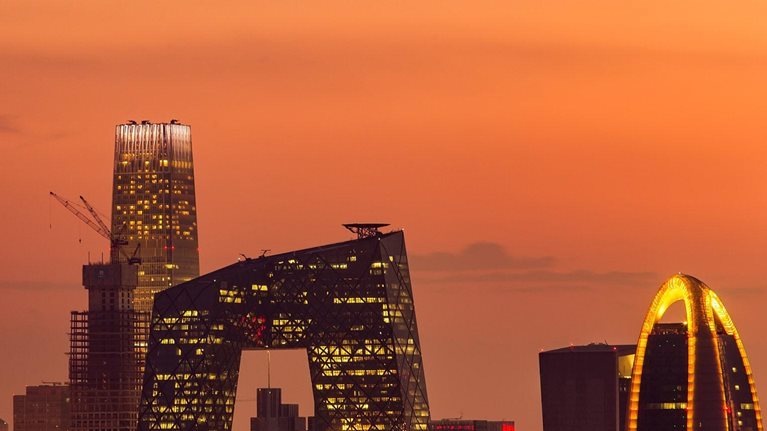The future of trade in Asia could depend heavily on what becomes of China’s expansive One Belt, One Road initiative, which calls for massive investment in and development of trade routes in the region. In this episode of the McKinsey Podcast, recorded in May, McKinsey senior partners Joe Ngai and Kevin Sneader talk with Cecilia Ma Zecha about One Belt, One Road—what it really means, what it needs to become a reality, and why people should take it seriously.
Podcast transcript
Cecilia Ma Zecha: Hello, and welcome to this edition of the McKinsey Podcast. I’m Cecilia Ma Zecha, an editor with McKinsey Publishing, based in Singapore. Today we’re going to be talking about one of the biggest stories in Asian business, China’s One Belt, One Road initiative, arguably its most ambitious economic and diplomatic program since the founding of the People’s Republic.
To explain One Belt, One Road and what it means to business, I’m joined today by Kevin Sneader, McKinsey’s chairman in Asia, and Joe Ngai, managing partner of McKinsey’s Hong Kong location. Kevin, let’s start from the very beginning, particularly for anyone listening outside of Asia. But frankly, for many of us who live and work in the region, behind the diplomatic language and the policy speak, what exactly is One Belt, One Road?
Kevin Sneader: At one level, One Belt, One Road has the potential to be perhaps the world’s largest platform for regional collaboration. What does that actually mean? There are two parts to this, the belt and the road, and it’s a little confusing. The belt is the physical road, which takes one from here all the way through Europe to somewhere up north in Scandinavia. That is the physical road. What they call the road is actually the maritime Silk Road, in other words, shipping lanes, essentially from here to Venice. Therefore it’s very ambitious—potentially ambitious—covering about 65 percent of the world’s population, about one-third of the world’s GDP, and about a quarter of all the goods and services the world moves.
Would you like to learn more about how we help clients in China?
That is what’s at the core of this—at least a potential trading route. The belt, the physical road, and the maritime Silk Road would re-create the shipping routes that made China one of the world’s foremost powers many, many years ago.
Cecilia Ma Zecha: Joe, why is this important now?
Joe Ngai: China is seeing a bit of a slowing down in its growth. A lot of people are saying that that’s part of the next growth wave of Chinese exports, which is that it’s going to have its influence and its infrastructure build-out in many of these countries, most of them emerging markets, in lots of things that frankly have fueled the very high growth in China over the past decade.
What remains to be seen is if that can be replicated in many of these countries in the next ten years. That is very significant. Because many of these countries are really lacking in this infrastructure. I remember when I take groups of delegates into China; they always marvel at the trains, the railway stations, the airports, and all that, which frankly is a bit of a miraculous creation in the past two decades.
The question is going to be how these are financed: whether there is going to be long-term planning that’s required, and whether the local governments and the state governments are able to take the Chinese model and the Chinese infrastructure and figure out how they can have their own version.
Kevin Sneader: Some people have talked about this being the second Marshall Plan. It’s worth recalling that the Marshall Plan, which obviously was at the heart of the regeneration of Europe after the Second World War, was one-twelfth the size of what is being contemplated in the One Belt, One Road initiative.
So the question is the scale. The ambition is enormous, and the sums of money are equally enormous. That is why I think whether this initiative is successful will have two parts to it. One will be that the funds are indeed available and that governments are willing to deploy them.
The second is that the money can actually be deployed wisely. There is a real risk that this becomes a source of funding that gets misdeployed and doesn’t end up contributing to greater trade or greater economic collaboration but just gets wasted on projects that really should never have been funded in the first place.
Cecilia Ma Zecha: It sounds like it’s a great concept, but it’s really far from becoming a reality. Can you elaborate on some of the challenges, such as funding and financing?
Kevin Sneader: I think the skepticism around whether this could be delivered has been at least partially allayed by looking at what’s already been achieved. Maybe let’s turn to the funding side and talk about that for a moment. The Asian Infrastructure Investment Bank (AIIB) has come into being.
There were lots of questions around whether that would happen. It’s $100 billion, the funding of which China provides somewhere between one-third and one-half, depending on how you look at it. That’s happened. Its governance is still being debated. But interestingly the governance model seems to have become a bit more transparent, a bit more recognized by the European powers that are involved than had initially been expected. So you tick one box and say that’s progress.
The Silk Road Fund has also come into being. Again, we’ll see how that unfolds. But that’s somewhere around $40 billion of investment. There were probably some bets around whether that would happen. Then there is the New Development Bank, which is the funding source for the BRICS countries. That has another $100 billion of investment allocated against it. These funding sources theoretically are beginning to move from the drawing board to at least some form of reality. How they operate, how they deploy, is still to be determined. But at least you can start to see how the big hurdle of funding is beginning to manifest itself in terms of tangible sources.
Cecilia Ma Zecha: The investment is a positive sign. But what’s the answer to that question: the deployment of these funds, how that will be operated? Joe, what do you think?
Joe Ngai: While we have the AIIB and the Silk Road Fund and the New Development Bank, if you add it all together, it’s still a very, very small amount relative to what needs to be funded, which is roughly between $2 trillion and $3 trillion per year.
You think about all the infrastructure across a third of the world’s GDP. The question is also going to be, even though you have these new banks and these new funds, whether they are able to change the way investors think about the risk in a lot of these emerging markets.
Whether they will tag along—infrastructure investment in a lot of the emerging markets is notorious for its risk. It’s long term, it’s political, and there are lots of uncertainties. People are pretty unwilling to do that investment for many, many years.
The fact that now China is putting together these consortiums of banks and funds and are standing behind it is a positive sign. What needs to happen, though, is the rest of the world needs to go along and use that as a way to get past a lot of the things that have inhibited progress in the past, namely getting very familiar with the risks in a lot of these countries.
Kevin Sneader: For this funding to be deployed, a lot of things need to come together. First of all, you need to have transparency, because if private money is going to be associated with this, and that recognizes Joe’s point today, the gap between the public funding and the private funding is what we need to talk about. That’s only going to get deployed if there are clear returns, transparency around the way that money gets allocated, a balanced approach so that the balance between the public funding and the private funding is appropriate, conduct that everybody can recognize as being close to market principles, and a regulatory system that’s able to work across borders. Those requirements are pretty substantial, and it’s fair to say that, at the moment, the rhetoric hasn’t yet delivered.
There’s a lot that’s got to happen before this moves off of the very grand and appropriate drawing board and into practical reality in some countries where it’s proved very difficult to deploy funds.
Joe Ngai: And frankly one of the other transparencies that needs to happen is around China’s intention. Because one of the things that people are going to look at is how much of this is political versus on the business side. For a lot of people, there’s still a little bit of suspicion or skepticism around whether this is part of China’s emergence as the next world power, to which obviously some countries are going to be a little bit less welcoming.
Cecilia Ma Zecha: How are you seeing other Asian countries view One Belt, One Road? You mentioned the risks involved for investors and how other countries have to go along. What are the implications for them? And how are they engaging with China?
Kevin Sneader: The implications are very significant. This week in Hong Kong there was a conference called the One Belt, One Road summit. And I chaired a panel with the delegates to that event from the Association of Southeast Asian Nations (ASEAN). It was quite interesting to look at the divergence, even within ASEAN.
The Indonesians were quite clearly excited about how is this going to play out. How is Chinese infrastructure investment going to make a difference in a place where they need that?
Malaysia is obviously one of the world’s great trading countries, whereas the Philippines is still quite internally focused. One of its challenges is to become a trading country. And so in Malaysia, at least the way that people were responding to the concept was one of, “Well, let’s see the economic output.” But there was enthusiasm.
Cecilia Ma Zecha: What are the other points of contention? How do you see Japan or the United States or other countries outside of Asia dealing with it?
Joe Ngai: If you follow the establishment of AIIB, it has been quite a geopolitical tension there in terms of who gets in first and who gets a say in it. Where is the first rail going to be built because of this? Where is the first funding? I’m not sure whether Japan or some of these other countries are going to be a big beneficiary of One Belt, One Road. It’s to be seen because there are a lot of countries.
The other question that’s out there is that China right now is also facing its own economic transition. We have seen enormous growth before. But it’s actually slowing down now. The capital markets in China are also going through a period where there are a lot of gyrations between the stocks.
You also see in China right now that there’s overcapacity in a lot of sectors. So the question is going to be, given that China is also in a transition economically, how much more attention these new enterprises can deploy overseas while domestically also fighting a few fires on its own turf.
It’s coming at a very interesting time because one can argue that this is part of how you deploy overseas. But it’s not as simple as that. In a lot of our work in different provinces in China, we see challenges internally in many, many places. So that’s going to be another tension: while One Belt, One Road is great, don’t forget that China also faces a lot of domestic challenges. That will need to be sorted out at the same time.
Cecilia Ma Zecha: We’re sitting in Hong Kong, and you’re both based here. Is there a role for Hong Kong to play with this initiative? And is it a significant role?
Kevin Sneader: The prospect of Hong Kong not playing a role is something that I think would be quite disappointing, or at least distressing on many levels, because I think Hong Kong’s role has been the gateway on many levels for China to the rest of the world.
While that role has been shifting, Hong Kong remains a vitally important financial center, an RMB trading center, and a source of advice, perspective, and assistance for Chinese companies and Western companies trying to work with each other. So it would be disappointing if Hong Kong somehow didn’t have a very important role to play here.

Capturing China’s $5 trillion productivity opportunity
What was intriguing in listening to the Chinese leadership—we had Chairman Zhang here this week, the number-three leader in China—was the degree to which he went out of his way to reaffirm two things: what he felt were the advantages that Hong Kong enjoyed and what he felt the opportunities were for Hong Kong.
On the advantages: its location. It’s very well located when you come to look at the map and figure out the trading routes. That’s why Hong Kong is what it is today. Second, there’s its open and free culture. This is a city that is the long-standing benchmark for openness—21 years at the top of the open-trade indexes and various others—so it is very much seen as a place where one can do business. Third, it’s a place where there is a lot of expertise. He went out of his way to name professional services in advisory, engineering, construction, a lot of talents that have been deployed to build modern China, which again the chairman talked about whether they can be taken elsewhere.
And, finally, culture. It’s a can-do culture, entrepreneurship, the kind of initiative taking that’s going to be important for this. When he mentioned those, he then said that should translate into a series of opportunities that mirror the four advantages. So the Chinese leadership went a pretty long distance to say, “We see Hong Kong as having a vital role.”
But it was also saying, I thought, “We expect you to play a role in this major initiative for China.” Whether Hong Kong chooses to play that role or not, that’s more complicated. Because ultimately it will hinge on the businesses and the leadership that’s here seeing something that they feel they can invest in and see a return and make a contribution around. But I would have thought there’s more upside than downside.
Cecilia Ma Zecha: Do you agree?
Joe Ngai: Sure. For Hong Kong professional services, I think that’s a real area where there’s a lot of upside. When you think about that in the past, as China was building out its infrastructure, a lot of Hong Kong bankers, people from construction, project engineers, all the way to your risk managers and all that. You can imagine that there’s a whole generation, really, of professional-services companies that grew up in the last decade because of the growth in China.
The question is whether you can actually take that and go into the One Belt, One Road countries and replicate the same story. There are going to be more challenges because China was something that was very convenient and very natural for Hong Kong given the Chinese language and everything else.
Now you go into countries where the language is going to be a challenge for everyone and where a lot of local traditions and legal systems and all that are going to be very different. We all have to learn. But to be honest, Hong Kong has more advantages than disadvantages. I also can’t see any other city that’s better positioned than Hong Kong to do a lot of these. As a Hong Kong national, I would say that it’s our game to lose, but at the same time, we have to strengthen quite a lot of muscle in order to play this game, too.
Cecilia Ma Zecha: So help people take stock here. If I am a business leader with operations and customers in Asia, what are the key takeaways? And what should I be looking out for in the coming months?
Kevin Sneader: For every skeptic, there are two optimists, and what was striking this week in looking at the gathering of business leaders was the sheer number of people who showed up and the breadth of the countries they represented and the businesses they were part of. While it’s going to be very easy to provide long explanations of why this won’t work, there are people already looking at what it’s going to take to make it work. We saw leading construction companies, leading financial companies, and leading advisory firms all looking to be involved. At this stage, the very practical side of this is, you could choose to sit out all of what we’ve just discussed. You could do so on the basis of this being a foreign-policy move. The economics are questionable. The geographic coverage is never going to be achieved. The financial returns won’t be offered.
You could make all those assumptions and sit out. Or you could say, “If I sit out, I may be missing out on the world’s largest trading collaboration for many, many years. Missing out on a set of theoretical opportunities that, if delivered, would amount to an enormous step change in infrastructure investment and the quality of trade.” And you would say to yourself, “Do I really want to sit that out? Or is it time to at least understand at a deeper level and invest some time and assets in doing so?”
My sense, based on where we are today, is I’d probably want to do the latter. In other words, participate and at least be part of the conversations, and only after that make the decision to not move forward.
Cecilia Ma Zecha: Kevin and Joe, thank you for joining us today. And thanks for listening to our conversation. If you’d like to find out more about our work in Asia, head over to McKinsey.com.


